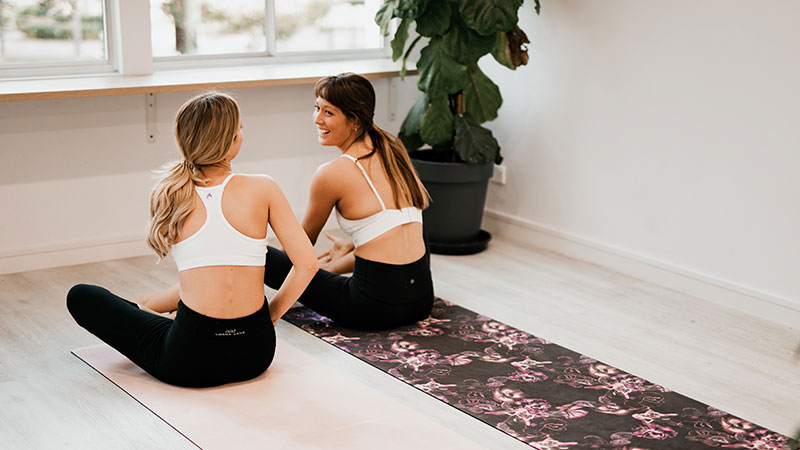Are you ready to embark on a journey of self-discovery and inner peace? Starting a yoga practice can be a transformative and enriching experience for both your body and mind. Whether you’re a complete beginner or someone looking to rekindle their yoga journey, this guide will help you take those first steps toward a more balanced and harmonious life through yoga.
1. Set your intention
Before you unroll your yoga mat, take a moment to reflect on why you want to practice yoga. Whether it’s to reduce stress, take better care of your body, enhance mindfulness, or seek spiritual growth, clarifying your intention will anchor your practice and keep you motivated. It will also enable you to seek out techniques that support your intention – for example, in order to reduce stress, you might want to focus on breathing exercises and some of the calmer styles of physical yoga practice like Yin Yoga.

2. Choose your practice
Over time, yoga has developed into various different styles and schools of thought. While the essence of yoga always stays the same, there are various routes in which you can arrive at the same goal. You can put more emphasis on meditation, or you could read about the principles of yoga. Physical yoga practice also comes in various flavors, each catering to different needs and preferences. Research different styles like Hatha, Vinyasa, Ashtanga, Yin, and more to find one that resonates with you. Each style has its unique focus and pace, so explore until you discover the one that aligns with your goals.
3. Find resources
In the age of technology, there’s an abundance of resources available to help you start your yoga journey. Look for online tutorials, yoga apps, and YouTube channels that offer guided classes. If you prefer in-person guidance, local yoga studios often provide introductory classes. You can also go deeper into your yoga practice with one of our personalized courses.
4. Create a comfortable space
Before you start your practice, find a space in your home where you can practice yoga comfortably. It doesn’t need to be large; a quiet corner with enough room for your mat or meditation cushion will suffice. Consider adding some calming elements like candles, plants, or soothing music to enhance the ambiance. The goal is to be as comfortable as possible.

5. Invest in basic equipment
You don’t need a lot of fancy gear to begin your yoga practice. When it comes to physical practice, a good quality yoga mat is definitely a plus, as it provides comfort, stability, and a non-slip surface. Depending on the style you choose, you might also want to have props like blocks, straps, and blankets to assist you in poses.
6. Start slowly
Yoga is a journey, not a destination. Take some time to explore what works for you. Feel free to get inspired by other yogis, but in the end it is up to you to get to know your own body and mind so that you can tailor your practice to your needs.
In your physical practice, start with beginner-friendly poses and sequences. Focus on mastering the foundational poses before progressing to more advanced ones. Don’t push your body too hard; listen to your body and respect its limitations.
7. Be consistent
Consistency is key when it comes to reaping the benefits of yoga. For example, meditating for 1 minute a day is much more effective than meditating for 7 minutes once a week, even though the overall time is the same. That is because your body and mind react best to repetition. Try to find a realistic way of practicing consistently that aligns with your daily routine and commitments – you don’t want to set yourself up for failure.
8. Embrace mindfulness
Yoga is not just about targeted practice; it’s also about cultivating mindfulness and self-awareness. Pay attention to your breath, sensations, and thoughts during your everyday activities. This mindfulness will gradually extend into other areas of your life, fostering a greater sense of presence.
9. Listen to your body
Yoga is a practice of self-care. Always prioritize your safety and well-being. If a pose feels uncomfortable or painful, modify it or skip it altogether. Your practice is about honoring your body’s needs, not pushing it to the brink.
10. Seek community and guidance
Consider joining yoga communities, both online and offline. Connecting with fellow practitioners can provide support, inspiration, and a sense of belonging. If you’re serious about deepening your practice, attending classes taught by experienced instructors can provide valuable guidance and corrections.

11. Patience and progress
Remember that progress in yoga is gradual. Celebrate small victories and improvements along the way. Your body will gradually become more flexible and stronger, and your mind will become more focused and calm. Remember that progress isn’t linear and there will be times when you find your practice more challenging than at other times. Even so, investing in your yoga practice is definitely worth it.
Starting a yoga practice is a beautiful journey of self-discovery, self-care, and personal growth. As you incorporate yoga into your daily routine, you’ll find that its benefits extend far beyond the physical realm, enriching your overall wellbeing. So get started, take a deep breath, and embrace the transformative power of yoga.
